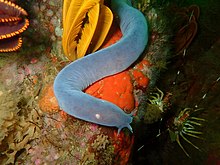| Eptatretus hexatrema | |
|---|---|

| |
| Off False Bay, South Africa | |
|
Scientific classification
| |
| Domain: | Eukaryota |
| Kingdom: | Animalia |
| Phylum: | Chordata |
| Infraphylum: | Agnatha |
| Class: | Myxini |
| Order: | Myxiniformes |
| Family: | Myxinidae |
| Genus: | Eptatretus |
| Species: | E. hexatrema
|
| Binomial name | |
| Eptatretus hexatrema (Müller, 1836)
| |
| Synonyms [1] [2] | |
| |
Eptatretus hexatrema, the sixgill hagfish, or snotslang is a species of marine fish in the hagfish family (family Myxinidae) of order Myxiniformes. It is native to the South Atlantic Ocean and southwestern Indian Ocean.
Distribution
Southeast Atlantic: known only from Walvis Bay, Namibia to Durban, South Africa [3]
Description
Maximum recorded length 80.0 cm. Depth of body 15 times total length. Six gill openings. Colour slaty grey. Egg cases ovoid about 30mm long by 12mm wide with anchor filaments at each end. [4] Eel shaped, with six barbels on the head around the mouth. Epatches form white spots under the skin. Two rows of slime pores under the body. [5] No paired fins, mouth has no jaws but has two protrusible rows of horny teeth. [6]
Habitat and behaviour
Non-migratory marine demersal. Depth range 10 – 400 m, usually found between 10 and 45 m. Commonly burrows in muddy bottoms. Feeds mostly by scavenging on dead or disabled fish. Secretes large quantities of slime when provoked. [6]
Importance to humans
No commercial value, considered a pest by fishermen.
Conservation status
Least concern
Name
Etymology: Eptatretus: Greek, epta = seven + Greek, tretos = with holes. hexatrema: ? .
Common names: sixgill hagfish, snotslang
Synonyms: Bdellostoma hexatrema Müller, 1836. Heptatretus hexatrema (Müller, 1836) [7]
References
- ^ Froese, R.; Pauly, D. (2017). "Myxinidae". FishBase version (02/2017). Retrieved 18 May 2017.
- ^ Van Der Laan, Richard; Eschmeyer, William N.; Fricke, Ronald (11 November 2014). "Family-group names of Recent fishes". Zootaxa. 3882 (1): 1–230. doi: 10.11646/zootaxa.3882.1.1. PMID 25543675.
- ^ Smith, Margaret M, and Heemstra, P. (eds.) 2003. Smith's sea fishes. South African Institute for Aquatic Biodiversity, Grahamstown. Struik publishers, Cape Town, 2003. ISBN 1 86872 890 0
- ^ Barnard, K. H. A Monograph of the Marine Fishes of South Africa, Part 1. Annals of the South African Museum. Vol. 21. Cape Town: South African Museum. p. 16. ISBN 0-949940-10-0.
- ^ Jones, Georgina. A field guide to the marine animals of the Cape Peninsula. SURG, Cape Town, 2008. ISBN 978-0-620-41639-9
- ^ a b Branch, G.M., Branch, M.L, Griffiths, C.L. and Beckley, L.E. (2010). Two Oceans: a guide to the marine life of southern Africa Struik Nature, Cape Town. ISBN 978 1 77007 772 0
- ^ Bailly, N. (2013). Eptatretus hexatrema (Müller, 1836). In: Froese, R. and D. Pauly. Editors. (2013) FishBase. Accessed through: World Register of Marine Species at http://www.marinespecies.org/aphia.php?p=taxdetails&id=221466 on 2014-03-19
Froese, Rainer; Pauly, Daniel (eds.) (2014). "Eptatretus hexatrema" in FishBase. March 2014 version.
"Eptatretus hexatrema". Integrated Taxonomic Information System. 19 March 2014.
External links
-
 Media related to
Eptatretus hexatrema at Wikimedia Commons
Media related to
Eptatretus hexatrema at Wikimedia Commons
